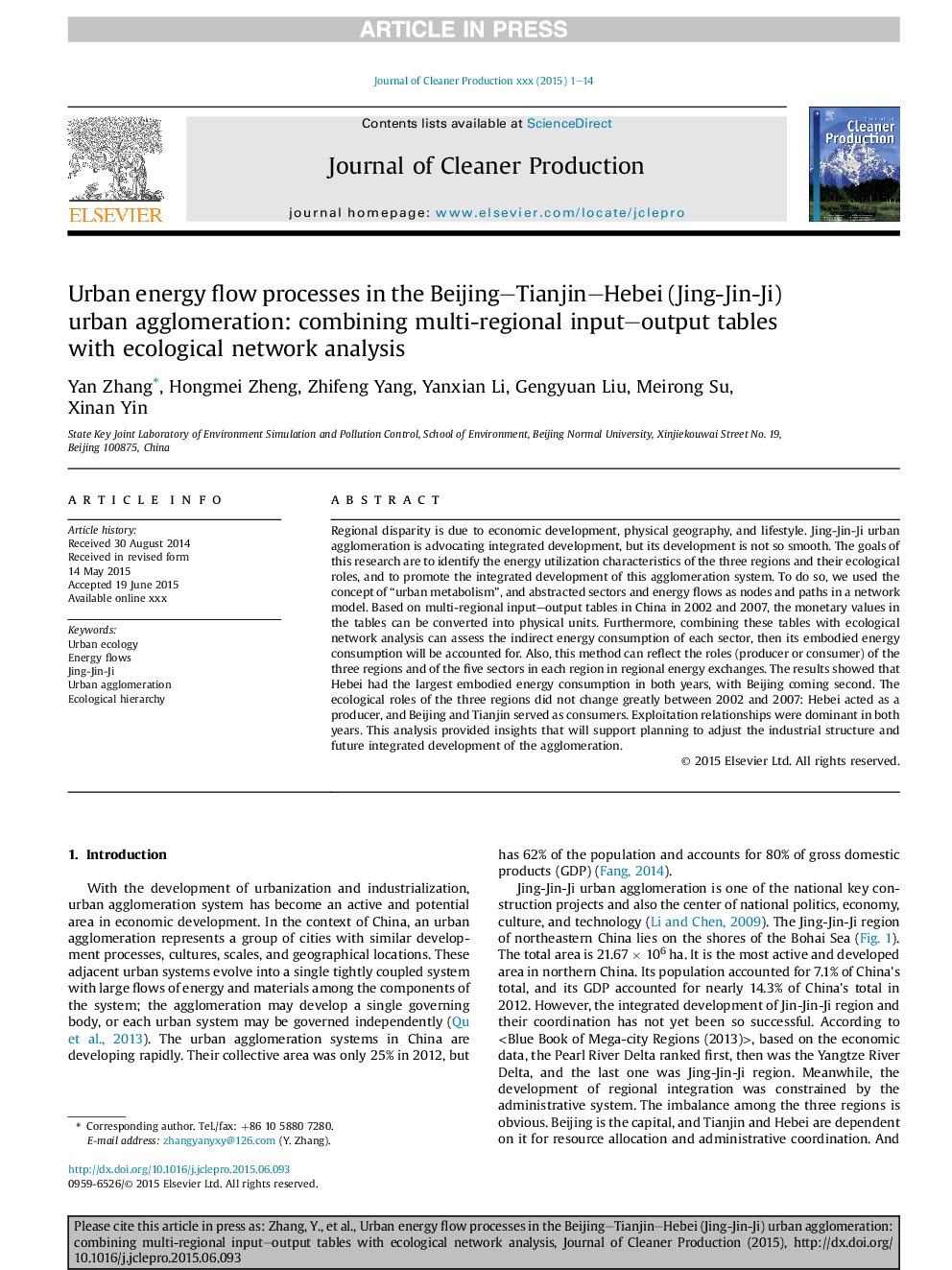| کد مقاله | کد نشریه | سال انتشار | مقاله انگلیسی | نسخه تمام متن |
|---|---|---|---|---|
| 8102734 | 1522135 | 2016 | 14 صفحه PDF | دانلود رایگان |
عنوان انگلیسی مقاله ISI
Urban energy flow processes in the Beijing-Tianjin-Hebei (Jing-Jin-Ji) urban agglomeration: combining multi-regional input-output tables with ecological network analysis
ترجمه فارسی عنوان
فرایندهای جریان انرژی شهری در تجمعات شهری پکن-تیانجین-هبی (جینگ جین جی): ترکیب جدول های ورودی-خروجی چند منطقه ای با تجزیه و تحلیل شبکه های اکولوژیکی
دانلود مقاله + سفارش ترجمه
دانلود مقاله ISI انگلیسی
رایگان برای ایرانیان
کلمات کلیدی
اکولوژی شهری، جریان انرژی، جینگ جین جی، تجمع شهری، سلسله مراتب اکولوژیک،
ترجمه چکیده
اختلافات منطقه ای ناشی از توسعه اقتصادی، جغرافیای فیزیکی و شیوه زندگی است. تجمع شهری جینگ جین جی از توسعه ی یکپارچه حمایت می کند، اما توسعه آن بسیار صاف نیست. اهداف این تحقیق عبارتند از شناسایی ویژگی های بهره برداری انرژی در سه ناحیه و نقش های اکولوژیکی آنها و ترویج توسعه ی مجتمع این سیستم جمع آوری. برای انجام این کار، ما از مفهوم متابولیسم شهری استفاده کردیم و بخش های انتزاعی و انرژی به عنوان گره ها و مسیرها در یک مدل شبکه جریان می یابد. بر اساس جداول ورودی-خروجی چند منطقه ای در چین در سال های 2002 و 2007، ارزش پولی در جداول می تواند به واحدهای فیزیکی تبدیل شود. علاوه بر این، ترکیب این جداول با تجزیه و تحلیل شبکه های اکولوژیکی می تواند میزان مصرف غیر مستقیم انرژی هر بخش را ارزیابی کند، سپس مصرف انرژی مجاز آن مورد توجه قرار گیرد. همچنین این روش می تواند نقش (تولید کننده یا مصرف کننده) سه منطقه و پنج بخش در هر منطقه در مبادلات انرژی منطقه ای را بازتاب دهد. نتایج نشان می دهد که هبی بیشترین میزان انرژی مصرف شده را در هر دو سال داشته است و پکن دومین تولید کننده آن است. نقش اکولوژیکی سه منطقه در سالهای 2002 تا 2007 به شدت تغییر نکرده است: هبی به عنوان تولید کننده عمل کرد و پکن و تیانجین به عنوان مصرف کننده خدمت می کردند. روابط بهرهبرداری در هر دو سال غالب بود. این تجزیه و تحلیل، بینش هایی را ارائه می دهد که از برنامه ریزی برای تنظیم ساختار صنعتی و توسعه یکپارچه آینده آگولومت حمایت می کند.
موضوعات مرتبط
مهندسی و علوم پایه
مهندسی انرژی
انرژی های تجدید پذیر، توسعه پایدار و محیط زیست
چکیده انگلیسی
Regional disparity is due to economic development, physical geography, and lifestyle. Jing-Jin-Ji urban agglomeration is advocating integrated development, but its development is not so smooth. The goals of this research are to identify the energy utilization characteristics of the three regions and their ecological roles, and to promote the integrated development of this agglomeration system. To do so, we used the concept of “urban metabolism”, and abstracted sectors and energy flows as nodes and paths in a network model. Based on multi-regional input-output tables in China in 2002 and 2007, the monetary values in the tables can be converted into physical units. Furthermore, combining these tables with ecological network analysis can assess the indirect energy consumption of each sector, then its embodied energy consumption will be accounted for. Also, this method can reflect the roles (producer or consumer) of the three regions and of the five sectors in each region in regional energy exchanges. The results showed that Hebei had the largest embodied energy consumption in both years, with Beijing coming second. The ecological roles of the three regions did not change greatly between 2002 and 2007: Hebei acted as a producer, and Beijing and Tianjin served as consumers. Exploitation relationships were dominant in both years. This analysis provided insights that will support planning to adjust the industrial structure and future integrated development of the agglomeration.
ناشر
Database: Elsevier - ScienceDirect (ساینس دایرکت)
Journal: Journal of Cleaner Production - Volume 114, 15 February 2016, Pages 243-256
Journal: Journal of Cleaner Production - Volume 114, 15 February 2016, Pages 243-256
نویسندگان
Yan Zhang, Hongmei Zheng, Zhifeng Yang, Yanxian Li, Gengyuan Liu, Meirong Su, Xinan Yin,
